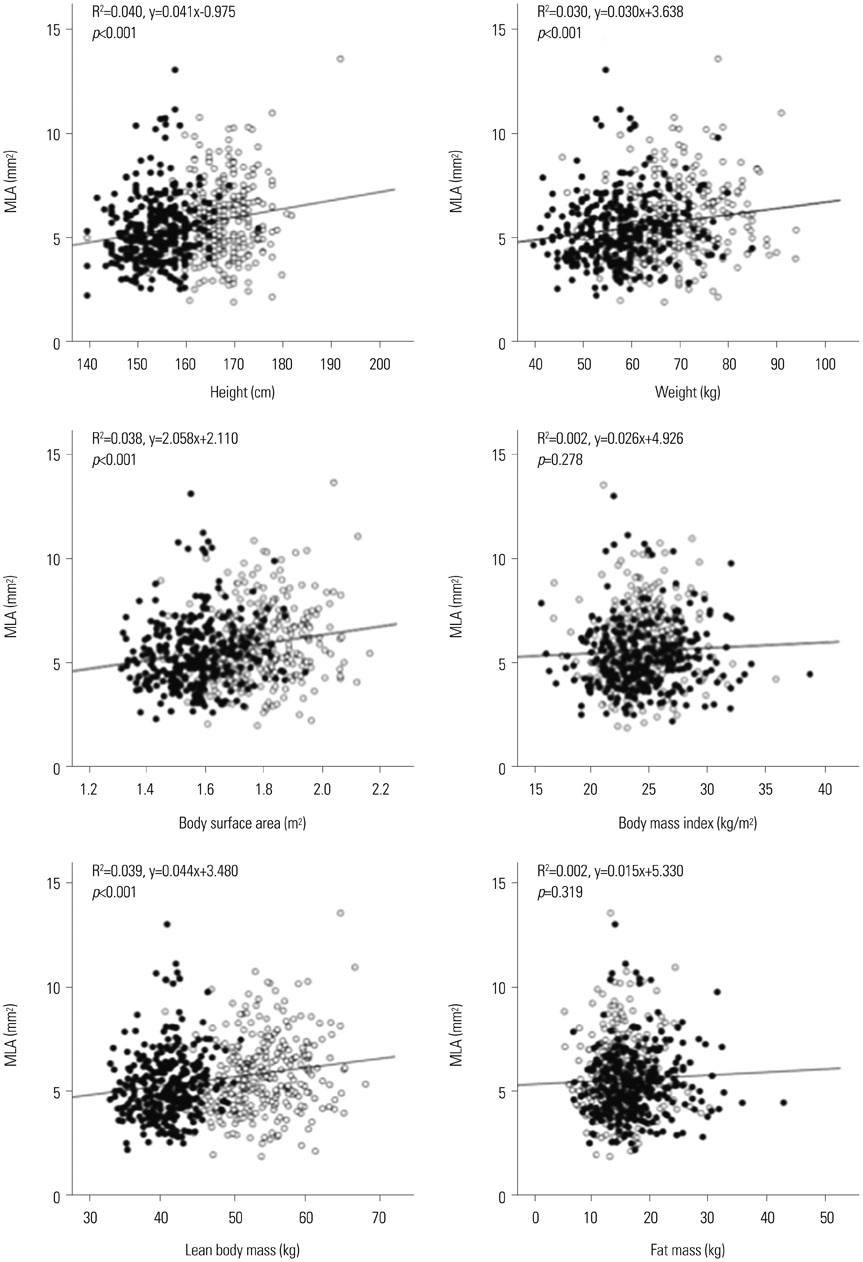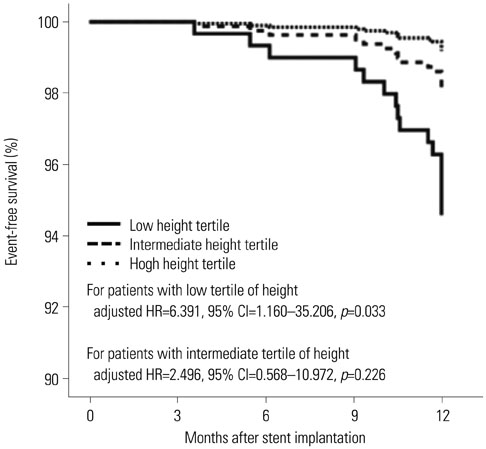Yonsei Med J.
2017 Mar;58(2):296-304. 10.3349/ymj.2017.58.2.296.
The Effect of Sex and Anthropometry on Clinical Outcomes in Patients Undergoing Percutaneous Coronary Intervention for Complex Coronary Lesions
- Affiliations
-
- 1Sanbon Hospital, Wonkwang University College of Medicine, Gunpo, Korea.
- 2Severance Cardiovascular Hospital, Yonsei University Health System, Seoul, Korea. MKHONG61@yuhs.ac
- 3Cardiovascular Research Institute, Yonsei University College of Medicine, Seoul, Korea.
- 4Severance Biomedical Science Institute, Yonsei University College of Medicine, Seoul, Korea.
- KMID: 2427117
- DOI: http://doi.org/10.3349/ymj.2017.58.2.296
Abstract
- PURPOSE
To evaluate the effects of sex and anthropometry on clinical outcomes in patients who underwent percutaneous coronary intervention (PCI).
MATERIALS AND METHODS
From three randomized trials (REal Safety and Efficacy of 3-month dual antiplatelet Therapy following Endeavor zotarolimus-eluting stent implantation, Impact of intraVascular UltraSound guidance on outcomes of Xience Prime stents in Long lesions, Chronic Total Occlusion InterVention with drUg-eluting Stents), we compared 333 pairs of men and women matched by propensity scores, all of whom underwent intravascular ultrasound (IVUS)-guided PCI for complex lesions.
RESULTS
For 12 months, the incidence of adverse cardiac events, defined as the composite of cardiac death, target lesion-related myocardial infarction, and target lesion revascularization, was not different between women and men (2.4% vs. 2.4%, p=0.939). Using multivariable Cox's regression analysis, post-intervention minimum lumen area [MLA; hazard ratio (HR)=0.620, 95% confidence interval (CI)=0.423-0.909, p=0.014] by IVUS was a predictor of adverse cardiac events. Height on anthropometry and lesions with chronic total occlusion were significantly related to post-intervention MLA. However, female sex was not independently associated with post-intervention MLA. In an age and sex-adjusted model, patients in the low tertile of height exhibited a greater risk for adverse cardiac events than those in the high tertile of height (HR=6.391, 95% CI=1.160-35.206, p=0.033).
CONCLUSION
Sex does not affect clinical outcomes after PCI for complex lesions. PCI outcomes, however, may be adversely affected by height.
MeSH Terms
-
Aged
*Anthropometry
Coronary Angiography/adverse effects
Coronary Artery Disease/diagnosis/*therapy
Coronary Vessels/diagnostic imaging
Drug-Eluting Stents/*adverse effects
Female
Humans
Incidence
Male
Middle Aged
Myocardial Infarction/epidemiology/etiology
Percutaneous Coronary Intervention/*adverse effects
Propensity Score
Proportional Hazards Models
Sirolimus/administration & dosage/adverse effects/*analogs & derivatives
Time Factors
Treatment Outcome
Ultrasonography, Interventional
Sirolimus
Figure
Reference
-
1. Lansky AJ, Hochman JS, Ward PA, Mintz GS, Fabunmi R, Berger PB, et al. Percutaneous coronary intervention and adjunctive pharmacotherapy in women: a statement for healthcare professionals from the American Heart Association. Circulation. 2005; 111:940–953.
Article2. Singh M, Rihal CS, Gersh BJ, Roger VL, Bell MR, Lennon RJ, et al. Mortality differences between men and women after percutaneous coronary interventions. A 25-year, single-center experience. J Am Coll Cardiol. 2008; 51:2313–2320.
Article3. Berger JS, Elliott L, Gallup D, Roe M, Granger CB, Armstrong PW, et al. Sex differences in mortality following acute coronary syndromes. JAMA. 2009; 302:874–882.
Article4. Anderson ML, Peterson ED, Brennan JM, Rao SV, Dai D, Anstrom KJ, et al. Short- and long-term outcomes of coronary stenting in women versus men: results from the National Cardiovascular Data Registry Centers for Medicare & Medicaid services cohort. Circulation. 2012; 126:2190–2199.
Article5. Wolff R, Fefer P, Knudtson ML, Cheema AN, Galbraith PD, Sparkes JD, et al. Gender differences in the prevalence and treatment of coronary chronic total occlusions. Catheter Cardiovasc Interv. 2016; 87:1063–1070.
Article6. Roberts CS, Roberts WC. Cross-sectional area of the proximal portions of the three major epicardial coronary arteries in 98 necropsy patients with different coronary events. Relationship to heart weight, age and sex. Circulation. 1980; 62:953–959.
Article7. Dodge JT Jr, Brown BG, Bolson EL, Dodge HT. Lumen diameter of normal human coronary arteries. Influence of age, sex, anatomic variation, and left ventricular hypertrophy or dilation. Circulation. 1992; 86:232–246.
Article8. Sheifer SE, Canos MR, Weinfurt KP, Arora UK, Mendelsohn FO, Gersh BJ, et al. Sex differences in coronary artery size assessed by intravascular ultrasound. Am Heart J. 2000; 139:649–653.
Article9. Elezi S, Dibra A, Mehilli J, Pache J, Wessely R, Schömig A, et al. Vessel size and outcome after coronary drug-eluting stent placement: results from a large cohort of patients treated with sirolimus- or paclitaxel-eluting stents. J Am Coll Cardiol. 2006; 48:1304–1309.10. Kim BK, Hong MK, Shin DH, Nam CM, Kim JS, Ko YG, et al. A new strategy for discontinuation of dual antiplatelet therapy: the RESET Trial (REal Safety and Efficacy of 3-month dual antiplatelet Therapy following Endeavor zotarolimus-eluting stent implantation). J Am Coll Cardiol. 2012; 60:1340–1348.11. Kim JS, Kang TS, Mintz GS, Park BE, Shin DH, Kim BK, et al. Randomized comparison of clinical outcomes between intravascular ultrasound and angiography-guided drug-eluting stent implantation for long coronary artery stenoses. JACC Cardiovasc Interv. 2013; 6:369–376.
Article12. Hong SJ, Kim BK, Shin DH, Nam CM, Kim JS, Ko YG, et al. Effect of intravascular ultrasound-guided vs angiography-guided everolimus-eluting stent implantation: the IVUS-XPL randomized clinical trial. JAMA. 2015; 314:2155–2163.
Article13. Kim BK, Shin DH, Hong MK, Park HS, Rha SW, Mintz GS, et al. Clinical impact of intravascular ultrasound-guided chronic total occlusion intervention with zotarolimus-eluting versus biolimus-eluting stent implantation: randomized study. Circ Cardiovasc Interv. 2015; 8:e002592.14. Mosteller RD. Simplified calculation of body-surface area. N Engl J Med. 1987; 317:1098.
Article15. Hallynck TH, Soep HH, Thomis JA, Boelaert J, Daneels R, Dettli L. Should clearance be normalised to body surface or to lean body mass? Br J Clin Pharmacol. 1981; 11:523–526.
Article16. Mintz GS, Nissen SE, Anderson WD, Bailey SR, Erbel R, Fitzgerald PJ, et al. American college of cardiology clinical expert consensus document on standards for acquisition, measurement and reporting of intravascular ultrasound studies (IVUS). A report of the American college of cardiology task force on clinical expert consensus documents. J Am Coll Cardiol. 2001; 37:1478–1492.
Article17. Cutlip DE, Windecker S, Mehran R, Boam A, Cohen DJ, van Es GA, et al. Clinical end points in coronary stent trials: a case for standardized definitions. Circulation. 2007; 115:2344–2351.18. Romero-Corral A, Montori VM, Somers VK, Korinek J, Thomas RJ, Allison TG, et al. Association of bodyweight with total mortality and with cardiovascular events in coronary artery disease: a systematic review of cohort studies. Lancet. 2006; 368:666–678.
Article19. Hastie CE, Padmanabhan S, Slack R, Pell AC, Oldroyd KG, Flapan AD, et al. Obesity paradox in a cohort of 4880 consecutive patients undergoing percutaneous coronary intervention. Eur Heart J. 2010; 31:222–226.
Article20. Lancefield T, Clark DJ, Andrianopoulos N, Brennan AL, Reid CM, Johns J, et al. Is there an obesity paradox after percutaneous coronary intervention in the contemporary era? An analysis from a multicenter Australian registry. JACC Cardiovasc Interv. 2010; 3:660–668.
Article21. Kang SJ, Mintz GS, Witzenbichler B, Metzger DC, Rinaldi MJ, Duffy PL, et al. Effect of obesity on coronary atherosclerosis and outcomes of percutaneous coronary intervention: grayscale and virtual histology intravascular ultrasound substudy of assessment of dual antiplatelet therapy with drug-eluting stents. Circ Cardiovasc Interv. 2014; 8:e001392.22. Karhunen PJ, Meinander T. Coronary artery disease: complex association between height and CHD-size matters. Nat Rev Cardiol. 2015; 12:385–386.
Article23. Paajanen TA, Oksala NK, Kuukasjärvi P, Karhunen PJ. Short stature is associated with coronary heart disease: a systematic review of the literature and a meta-analysis. Eur Heart J. 2010; 31:1802–1809.
Article24. Emerging Risk Factors Collaboration. Adult height and the risk of cause-specific death and vascular morbidity in 1 million people: individual participant meta-analysis. Int J Epidemiol. 2012; 41:1419–1433.25. Rosenberg MA, Lopez FL, Bůžková P, Adabag S, Chen LY, Sotoodehnia N, et al. Height and risk of sudden cardiac death: the atherosclerosis risk in communities and cardiovascular health studies. Ann Epidemiol. 2014; 24:174–179.e2.
Article26. Nelson CP, Hamby SE, Saleheen D, Hopewell JC, Zeng L, Assimes TL, et al. Genetically determined height and coronary artery disease. N Engl J Med. 2015; 372:1608–1618.
Article27. Fisher LD, Kennedy JW, Davis KB, Maynard C, Fritz JK, Kaiser G, et al. Association of sex, physical size, and operative mortality after coronary artery bypass in the Coronary Artery Surgery Study (CASS). J Thorac Cardiovasc Surg. 1982; 84:334–341.
Article28. Choi YJ, Kim JB, Cho SJ, Cho J, Sohn J, Cho SK, et al. Changes in the practice of coronary revascularization between 2006 and 2010 in the Republic of Korea. Yonsei Med J. 2015; 56:895–903.
Article29. Park DW, Kim YH, Yun SC, Ahn JM, Lee JY, Kang SJ, et al. Sex difference in clinical outcomes after percutaneous coronary intervention in Korean population. Am Heart J. 2014; 167:743–752.
Article30. Kang WY, Jeong MH, Ahn YK, Kim JH, Chae SC, Kim YJ, et al. Obesity paradox in Korean patients undergoing primary percutaneous coronary intervention in ST-segment elevation myocardial infarction. J Cardiol. 2010; 55:84–91.
Article
- Full Text Links
- Actions
-
Cited
- CITED
-
- Close
- Share
- Similar articles
-
- Gender Is Not Predictor for Clinical Outcomes in Patients Undergoing Percutaneous Coronary Intervention for Coronary Bifurcation
- PCI Optimization Using Intravascular Imaging: Insights From Recent Trials
- Percutaneous coronary intervention in patients with multi-vessel coronary artery disease: a focus on physiology
- Recent Advances in Percutaneous Coronary Intervention in Coronary Artery Disease
- Novel Coronary Stent Platforms



